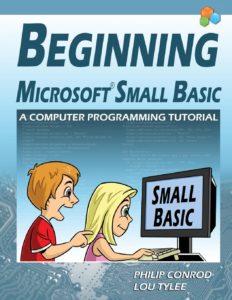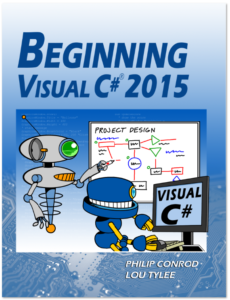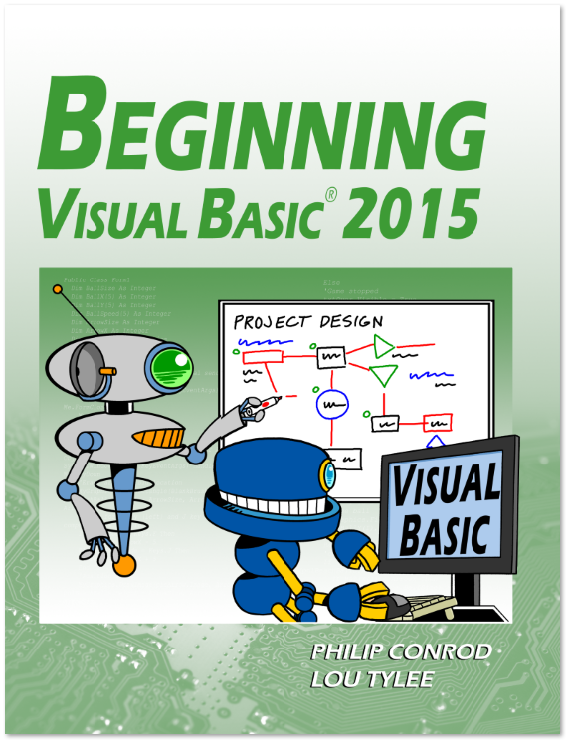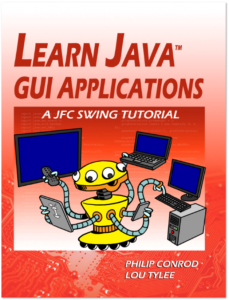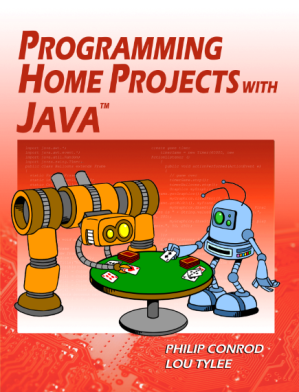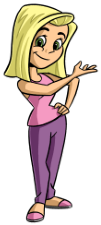
Beginning Computer Programming Tutorials for High School Home Self-Study and/or Homeschool Students
“I like the Computer Science For Kids Textbooks. They are clearly written and easy to understand. All in all, you folks have done a great job!”
– Peter Eramo, Teacher, Poland Central School, Poland, NY
“Phil Conrod has a passion for writing tutorials and books aimed at beginner programmers and he’s done an excellent job of covering all the fundamentals of Small Basic programming.” – Vijaye Raji, Creator of Microsoft Small Basic
OVERVIEW
Every kid or teenager who plays video games wishes they knew how to write their very own video games! With our “at-home” Computer Science For Kids Programming Tutorials, your kids can learn to develop their own kid-friendly non-violent video games and other career building computer applications with no parent programming experience needed. Our self-study and self-paced computer programming tutorials have been used all over the world by computer enthusiasts, schools, homeschool parents and homeschool co-ops for over 30 years.
We currently offer computer programming tutorials for Microsoft Small Basic, Microsoft Visual Basic, Microsoft Visual C#, and Oracle Java. The Microsoft Small Basic Programming Track is designed for students starting at 10 years of age. Our Visual Basic, Visual C#, and Java Tutorials are designed for eighth grade students and above. If your middle school student has successfully completed our Small Basic tutorial they can easily move right into any of the other Beginning language tutorials. All of our tutorials are self-paced and self-study so they are designed for “parent-friendly” independent learning. Some students age 10-12 may need some assistance with advanced math concepts like square roots.
So where should your student start? If you or your student have no previous computer programming experience, we highly recommend you start with our Microsoft “Small Basic” Programming Track for beginners. If you personally have experience with Visual Basic, Visual C# or Java and you want to provide some personal coaching and guidance to your student along the way, we suggest you pick the computer language you are most familiar with. If you and your student are both new to computer programming, start with the Small Basic Track #1 below. So with that introduction, let’s review each of our “parent-friendly” self-study computer programming tutorials in more detail.
MICROSOFT SMALL BASIC PROGRAMMING TRACK
The Small Basic Track can be used for either beginning Middle School or High School Students. The first semester tutorial is designed for the absolute beginning programmer. The second semester tutorial is an intermediate tutorial focused on useful projects that the student can use at home.
The Beginning Microsoft Small Basic Programming Tutorial is a self-study first semester “beginner” programming tutorial consisting of 11 chapters explaining (in simple, easy-to-follow terms) how to write Microsoft Small Basic programs. It expands in more depth on the topics outlined in the introductory Small Basic Powerpoint Beta Tutorial by Microsoft. The last chapter of this tutorial shows you how four different Small Basic games could port to Visual Basic, Visual C# and Java. The programming tutorial is appropriate for kids, teens and adults.
Programming Home Projects with Microsoft Small Basic is a self-paced third semester “intermediate” level programming tutorial consisting of 10 chapters explaining (in simple, easy-to-follow terms) how to write home projects in Microsoft Small Basic. Students will learn how to program the following Small Basic video games: Dual-Mode Stopwatch, Consumer Loan Assistant, Flash Card Math Quiz, Multiple Choice Exam, Blackjack Card Game, Weight Monitor, Home Inventory Manager, and a Snowball Toss Game. This programming programming tutorial is appropriate for kids, teens and adults.
MICROSOFT VISUAL C#® PROGRAMMING TRACK
Visual C#® for High School Students has 4 semester long tutorials. The first semester tutorial designed for the absolute beginner early high-school programmer. The second semester tutorial is an intermediate tutorial focused on building useful homework projects that the student can use at home. The third and fourth semester tutorials are more rigorous Honors Level tutorials for advanced students and are designed to prepare your students for college Level programming courses.
Beginning Visual C# – Teacher Pack (1st Semester)
BEGINNING VISUAL C#® is a semester long “beginning”programming tutorial consisting of 10 chapters explaining (in simple, easy-to-follow terms) how to build a C# Windows application. The tutorial is appropriate for teens and adults.
Learn Visual C# – Teacher Pack (3rd Semester)
LEARN VISUAL C# is a comprehensive college-prep programming tutorial covering object-oriented programming, the Visual C# Professional integrated development environment, building and distributing Windows applications using the Windows Installer, exception handling, sequential file access, graphics, multimedia, advanced topics such as web access, printing, and HTML help system authoring. The tutorial also introduces database applications (using ADO .NET) and web applications (using ASP.NET). Students will also develop their own objects. Some of the applications built include: Stopwatch, Calendar Display, Loan Repayment Calculator, Flash Card Math Game, Database Input Screen, Statistics Calculator, Tic-Tac-Toe Game, Capital City Quiz, Information Tracker (with plotting), Line, Bar and Pie charts, a version of the first video game ever – Pong, and a digital Telephone Directory.
Visual C# and Databases – Teacher Pack (4th Semester)
VISUAL C# AND DATABASES is a tutorial that provides a detailed introduction to using Visual Basic for accessing and maintaining databases for desktop applications. Topics covered include: database structure, database design, Visual C# project building, ADO .NET data objects (connection, data adapter, command, data table), data bound controls, proper interface design, structured query language (SQL), creating databases using Access, SQL Server and ADOX, and database reports. Actual projects developed include a books tracking system, a sales invoicing program, a home inventory system and a daily weather monitor.
MICROSOFT VISUAL BASIC® PROGRAMMING TRACK
Visual Basic® for High School Students has 5 semester long tutorials. The first semester tutorial designed for the absolute beginner early high-school programmer. The second semester tutorial is an intermediate tutorial focused on building useful homework projects that the student can use at home. The third and forth semester tutorials are more rigorous Honors Level tutorials for advanced students and are designed to prepare your students for college level programming courses.
Beginning Visual Basic – Teacher Pack (1st Semester)
BEGINNING VISUAL BASIC® is a semester long self-paced “beginner” programming tutorial consisting of 10 chapters explaining (in simple, easy-to-follow terms) how to build a Visual Basic Windows application. The tutorial is appropriate for both teens and adults.
Learn Visual Basic – College Prep – Teacher Pack (4th Semester)
LEARN VISUAL BASIC is a comprehensive college-prep programming tutorial covering object-oriented programming, the Visual Basic Professional integrated development environment, building and distributing Windows applications using the Windows Installer, exception handling, sequential file access, graphics, multimedia, advanced topics such as web access, printing, and HTML help system authoring. The tutorial also introduces database applications (using ADO .NET) and web applications (using ASP.NET). Some of the applications built include: Stopwatch, Calendar Display, Loan Repayment Calculator, Flash Card Math Game, Database Input Screen, Statistics Calculator, Tic-Tac-Toe Game, Capital City Quiz, Information Tracker (with plotting), Line, Bar and Pie charts, a version of the first video game ever – Pong, and a digital Telephone Directory. This curriculum was used in a major university’s introductory Visual Basic course for over a decade.
Visual Basic and Databases – Teacher Pack (5th Semester)
VISUAL BASIC AND DATABASES is a tutorial that provides a detailed introduction to using Visual Basic for accessing and maintaining databases for desktop applications. Topics covered include: database structure, database design, Visual Basic project building, ADO .NET data objects (connection, data adapter, command, data table), data bound controls, proper interface design, structured query language (SQL), creating databases using Access, SQL Server and ADOX, and database reports. Actual projects developed include a books tracking system, a sales invoicing program, a home inventory system and a daily weather monitor.
ORACLE® JAVATM PROGRAMMING TRACK
The JavaTM Programming Track has 4 semester long tutorials. The first semester tutorial designed for the absolute beginner Java programmer. The second semester in an intermediate tutorial focused on building Graphical User Interfaces using JAVA. The third semester tutorial is an intermediate tutorial focused on building useful homework projects that the student can use at home.
Beginning Java – Teacher Pack (1st Semester)
BEGINNING JAVA is a semester long “beginning” programming tutorial consisting of 10 chapters explaining (in simple, easy-to-follow terms) how to build a Java application. The games built are non-violent and teach logical thinking skills. The tutorial is appropriate for both teens and adults.
Learn Java GUI Applications, A JFC Swing Tutorial – Teacher Pack (2nd Semester)
LEARN JAVA GUI APPLICATIONS is a 9 lesson Tutorial covering object-oriented programming concepts, using a integrated development environment to create and test Java projects, building and distributing GUI applications, understanding and using the Swing control library, exception handling, sequential file access, graphics, multimedia, advanced topics such as printing, and help system authoring. The tutorial is appropriate for both teens and adults.
Programming Home Projects with JavaTM – Teacher Pack (4th Semester)
PROGRAMMING HOME PROJECTS WITH JAVATM explains (in simple, easy-to-follow terms) how to build a Java GUI project. Students learn about project design, the Java Swing controls, many elements of the Java language, and how to distribute finished projects. The projects built include: Dual-Mode Stopwatch, Consumer Loan Assistant, Flash Card Math Quiz, Multiple Choice Exam, Blackjack Card Game, Weight Monitor, Home Inventory Manager, and a Snowball Toss Game.
What Others Are Saying about our Tutorials…..
“The tutorials were really good to use. I have a very small class of three and I found them to be much better than a book.”
“I like the tutorials. They were easy to follow using laymen’s terms.”
“The Learn Java (GUI Applications) For High School Students topics are introduced progressively to ensure that students of different levels can progress at their own pace. Many exercises and problems are weaved into the chapters to maintain student interest and build confidence. Overall, I appreciated your efforts to make the Java product user friendly.“
“I was looking for some Visual Basic Express ideas and these books appeared to be just what I needed. I bought both Visual Basic books. Great ideas and easy to read.”
“I enjoyed both books. I liked the format, Word & PDF, that way i can teach on my iPad. I’ll be back for more next year.”

